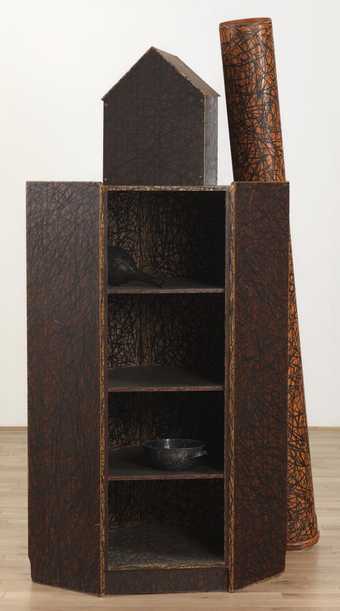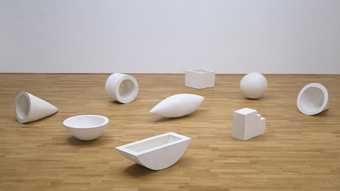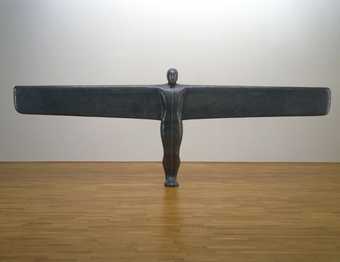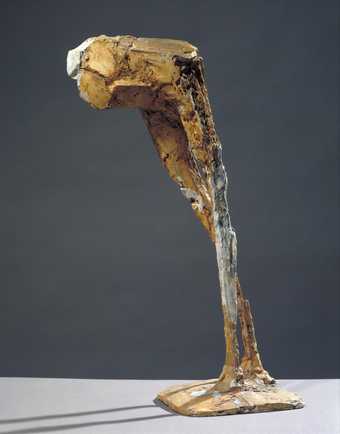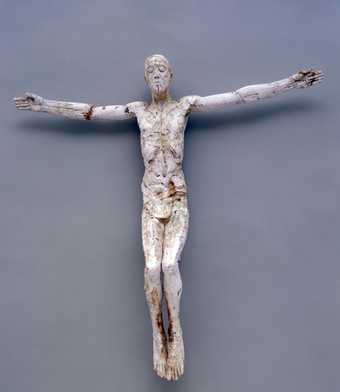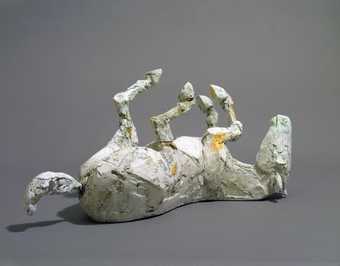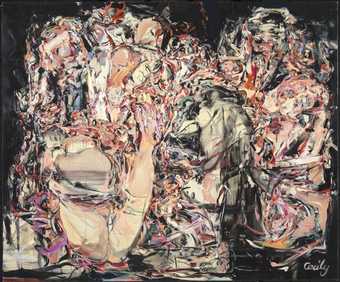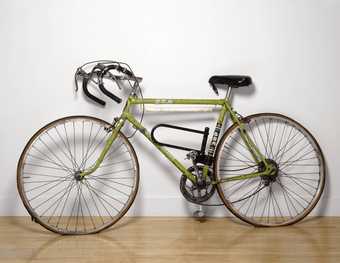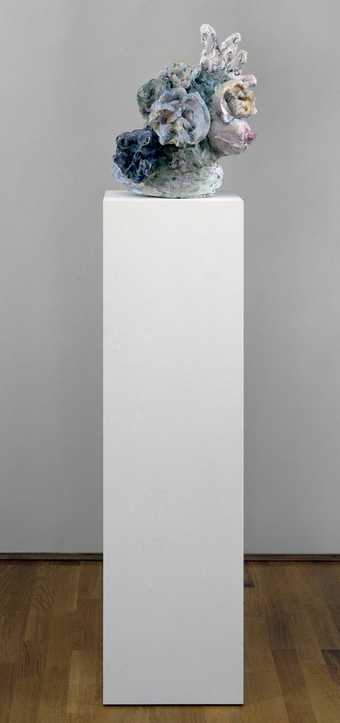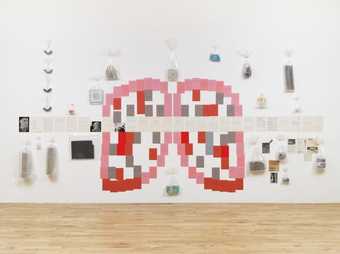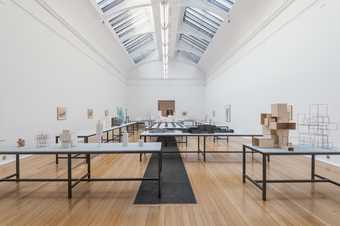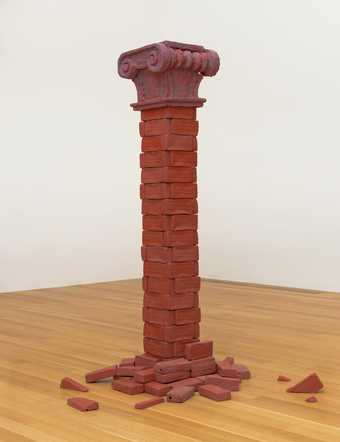
Not on display
- Artist
- Edward Allington 1951–2017
- Medium
- Plastic pineapples, polystyrene, plaster and steel
- Dimensions
- Overall display dimensions variable
- Collection
- Tate
- Acquisition
- Accepted by HM Government in Lieu of Inheritance Tax from the estate of Edward Allington and allocated to Tate 2021
- Reference
- T15762
Summary
From the Birth of Paradise 1983 consists of a gilded polystyrene representation of a shell, seemingly floating in mid-air, from which tumble differently sized plastic pineapples, a number of which lie on the floor around it. Those pineapples that are emerging directly from the mouth of the shell are attached to and disguise an armature that supports the shell from the floor. Edward Allington was identified with the emergence of new image sculpture in Britain at the end of the 1970s and early 1980s, corresponding with the growing prominence of neo-expressionist, new image painting – characteristically portrayed as a reflection of postmodern aesthetics and philosophy that had previously been ascribed to architecture. This outlook was based on a collage approach to materials as much as to source imagery or style, ideals and principles; within architecture this was exemplified by prominent post-modern buildings such as that for the offices and studios of TV-am in London, designed in 1981–3 by Terry Farrell (born 1938), featuring a Japanese temple, a Mesopotamian ziggurat and eleven rooftop eggcups – mixing cultures, styles and periods.
The year before making From the Birth of Paradise, Allington made Oblivion Penetrated 1982 (Tate T06895), a sculpture which follows similar strategies, being a gilded cornucopia from which fruits and leaves cascade. Yet, at the root of Allington’s work is his engagement with a clash of traditions and philosophies between classical forms and ideals and the language of the street and popular culture. Like that of many of his contemporaries, his work is characterised by a use of cheap found materials that connect with the immediacy of contemporary everyday life. Allington’s sculpture in the early 1980s, however, did not simply involve a straightforward clash of different styles and historical periods, but was driven by the urge to communicate what the critic Michael Newman identified as:
a sense of falsity and loss … experienced in the manifestation of pleasure and abundance, framed as the degradation of a Classical heritage … The shell is a husk, a dead thing which once contained and protected soft, living substance. It is also the typical motif of the Baroque, faced as that epoch was by the terrifying and ever-present possibility of the withdrawal of the divine from its immanence in mater … When Allington gilds his shells by applying a coat of gold paint, the deathliness of the shell is doubled with allurement of artifice.
(Michael Newman, ‘Discourse and Desire, Recent British Sculpture’, Flash Art, no.115, January 1984, pp.54–5.)
From the Birth of Paradise describes a link between the real and the fake as much as how that relationship might also be about reproducibility in the face of a loss of origins. Although the use of plastic fruit suggests an interest in the fake as a form of appropriated image, Allington’s sculpture at this time was more fundamentally involved in working through the principles of kitsch that the critic Stuart Morgan recognised in ‘his awareness of the divisions between the unified and fragmented, the “high” and the “low” in the classical tradition as he sees it. (And “as he sees it” is vital because his classical world is perhaps a reconstruction of his own.)’ (Stuart Morgan and Kate Blacker, ‘Loose talk’, The Sculpture Show, exhibition catalogue, Hayward and Serpentine Galleries, London 1983, p.96.)
For Allington the issue of kitsch centred around the continued life of high art within the everyday and he first recognised this position in 1970 following a visit to Athens when he sensed a difficulty in locating the original, real or ancient Parthenon in the face of restoration, reconstruction and the versions of the Parthenon created for tourists. The paradise of this sculpture’s title describes not only a world of plenty and abundance, figured here as a cornucopia of exotic fruit, but is also a view of what the birth of culture might be when faced by the absence of origin. Allington declared that he aimed to find a way ‘to assimilate the many absurdities of our age, whereby I might create works so ironic, even voluptuous and beautiful that they would echo the cultural paradox of the reality of today.’ (Edward Allington, untitled statement, Edward Allington, exhibition invitation card, Lisson Gallery, London 1984.)
Further reading
Edward Allington, In Pursuit of Savage Luxury, exhibition catalogue, Midland Group Nottingham 1984.
Edward Allington: New Sculpture, exhibition catalogue, Riverside Studios, London 1985.
Edward Allington, exhibition catalogue, Cornerhouse, Manchester 1993.
Andrew Wilson
October 2018
Does this text contain inaccurate information or language that you feel we should improve or change? We would like to hear from you.
You might like
-
Tim Scott Pool V
1971 -
Tony Cragg Mineral Vein
1986 -
Edward Allington Ideal Standard Forms
1980 -
Sir Antony Gormley OBE RA A Case for an Angel III
1990 -
Dame Elisabeth Frink Harbinger Bird
c.1965 -
Dame Elisabeth Frink Salisbury Madonna
c.1981 -
Dame Elisabeth Frink Crucifix for a Lutheran Church
c.1983 -
Dame Elisabeth Frink Horseman (Robed)
c.1985 -
Dame Elisabeth Frink Horse Rolling Over
c.1986 -
Cecily Brown Trouble in Paradise
1999 -
Elizabeth Wright B.S.A. Tour of Britain Racer Enlarged to 135%
1996–7 -
Rebecca Warren OBE Versailles
2006 -
Conrad Atkinson Asbestos
1978 -
Sir Antony Gormley OBE RA The Model Room
1994–2013 -
Edward Allington Architectural Fragment / Third column
1986


